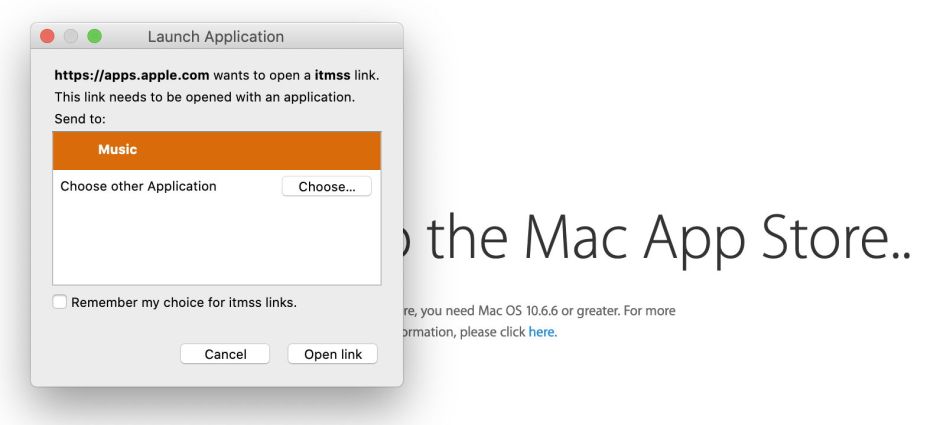You may be puzzled why some of Apple’s links don’t seem to work. Take, for example, the link which is provided to download the Mojave installer in this article. What is given seems to be a page in an iTunes site, but in some browsers doesn’t work properly.
Try those links in Safari, and what should happen is that a page opens in Safari informing you that you’ve been redirected to the App Store. The App Store app then opens, and takes you to the hidden page from which you can download the Mojave installer.
Try this in Firefox (81.0), though, and the result is less rewarding.

You’re first prompted to select an app with which to open a different link altogether. As Music is the wrong app, you click on the Choose… button.

Knowing it requires the App Store app, you select that instead of Music.

You then try to open the different link using the App Store app.

Although that does open the App Store app, the attempt to connect to the hidden page containing Mojave still fails.
Brave (85.1.14.84) is a bit different, though.

It recognises correctly that the link must be opened in the App Store. And it does that, transferring to the page from which you can download Mojave.

Even Brave doesn’t quite get it right, though. When the correct page has been loaded in the App Store, underlying its dialog is an error message reporting that the page is missing, and offering to find it on the Wayback Machine.
Why all these problems, and what is an ITMSS?
These ‘links’ are, of course, URIs, Uniform Resource Identifiers, the generic form of URLs. These include more than just the standard schemes like http and https: mailto and ftp are other examples which you’ll encounter. A URI is structured thus:
scheme:[//authority]path[?query][#fragment]
and it’s the scheme here which is causing the problem.
itmss stands for iTunes Music Store Secure, a proprietary protocol defined by Apple. Your browser then has to associate that scheme with an application, so that it can pass the whole URI to that app for it to deal with. When Firefox tries to do that, the rest of the URI isn’t being passed correctly, so the App Store app opens and then can’t find the path to the right page. Brave has got the hang of this, and does it without knowing that it has done the right thing.
So, if your default browser is Firefox and you try opening one of Apple’s App Store links, it’s doomed to fail. The best workaround is to copy that link, paste it into Safari, and connect to it from there.

